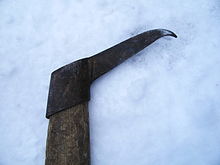Sappie
The sappie (partly in the spelling Sapie , regionally also known as Sappel , Sappl , Sapin , Zapin and Griesbeil ) is a tool for manual wood backing in forestry that combines the functions of hammer and turning hook . It was also used as a mountain stick in the Alpine region .

etymology
The word is derived from the Italian zappa , hoe, rake, hoe , in the form zappina , and was adopted into German in a wide variety of variants via the spoken word of forestry work.
Regional names
The expression Sappie (formerly "the Sappie") is the usual trade name for the tool in Germany and probably comes from French into German (see Sappeur in the military), whereas in Tyrolean-Salzburg one speaks mostly of Sappel , fidget or Zapin , regional differences also of the saps and the Sapine . In Upper and Eastern Austria the name is often the sapin , more rarely the zapin , the zappin or the zapfl , in Switzerland zappi or zapin . The Italian-grammatically correct female form, the zapine or sapine, is rarely found in linguistic usage, occasionally the sapon / zapon from Italian zappone , strong / large hoe (where 'hoe' stands for the small ax ).
Construction and function
A sappie consists of an approx. 25-30 cm long, slightly curved steel tip attached at an angle of approx. 120 ° to an approx. 1 m long handle (handsappies with <50 cm handle), which is worked out into a flat hammer on the back is. The sappies common today have a head weight of 1100 to 1300 grams and are often serrated on the top for better grip. Handsappies , on the other hand, only weigh around 400 grams and, with a handle length of 30–80 centimeters, make work easier when processing meter pieces. Alternatively, a splitting hammer with a turning nose can be used here.
use
forestry
With the tip hammered into the lying wood, it can be lifted or turned. The flat striking piece is used to hammer in and remove the back hooks ( lightning hook, shag hook ).
Rockclimbing
Historically, it was common for Sappie to weigh less, they were - additionally equipped with an iron spike at the lower end of the handle - so they could also be used as a mountain stick and were a common companion for the locals in the Alpine region. This is why the tool found its way into works by local poets such as Ludwig Ganghofer or Franz von Kobell under the name "Griesbeil", which was common at the time . The Upper Bavarian municipalities of Siegsdorf , Reit im Winkl , Ramsau and Ruhpolding show a sappie or griesbeil in their municipal coat of arms.
Occupational safety
Compared to an ax or splitting hammer , the sappie itself is a tool with a low risk of injury, because a light blow is enough to drive it into the wood and is therefore not reached overhead. Driving in steel wedges with the hammer should be avoided because of the risk of splinters; aluminum or plastic wedges should be used here.
Accidents when using the sappies can occur if the weight of the wood moved by the strong leverage is underestimated. Trunks that got stuck during felling should not be pulled down with the sappie; a winch is preferable here.
A single person cannot work on stacked long logs that are to be pulled to the ground for sawing: Here two people, each with a sappie, have to pull the pieces forward at an angle from the outside in order to remain outside the direct danger area of the unrolling wood.
Web links
Individual evidence
- ↑ Sappie | Spelling, meaning, definition, origin. In: Duden. Retrieved May 7, 2020 .
- ↑ Sappl (Sapl, Zapin, Sappie) and back devices. In: binder-krieglstein.com. Retrieved May 7, 2020 .


